PEMF Signal Analysis
335 Studies
Analysis → Verdict Proofs.
We analyzed PubMed PEMF studies—not brand claims—to try and find out what really was the most effective PEMF signal setting.
These are the analyses that form evidence backing our top PEMF mat picks, back our data-driven answers to PEMF, and led us to our clear verdict on effective PEMF settings.
Findings
There is no “perfect” or “most effective” PEMF signal.
Positive outcomes appear across a VAST range of frequencies, intensities, and waveforms.
Certain ranges tend to have a heavier weighting of positive outcomes, such as low frequency/intensity bands.
Why it matters?
We learn almost every form of PEMF, regardless of waveform, frequency, or intensity has shown to some extent positive results in studies
This means that every PEMF mat should be beneficial in some way, and there probably isn’t “one” most effective PEMF mat or device
It means if you want the most out of PEMF, get a mat that offers the most PEMF: most frequencies, intensities, and waveforms
Get the full process, details, and explanation
Analysis Methods
Macro-Method
Find as many PEMF studies on Pubmed as possible which include PEMF setting info (frequency, intensity, waveform; we found 335)
Record the findings of the studies and their settings
Chart the PEMF settings of the studies along with the study outcomes to see where positive outcomes are found


Micro-Method
Focused on only the most relevant PEMF research studies (we found 56 in this older analysis we did)
Applied the same process as with the macro-method to find out what PEMF settings were finding positive results
Get the full process, details, and explanation
Proofs
Chart Results
The charts we made from the database showing how many positive results were within certain frequency/intensity range bands and then frequency & intensity PEMF settings which found positive results.
See the larger versions of the charts in the actual analyses below, along with full explanations like for example what the heck “log scale” means!
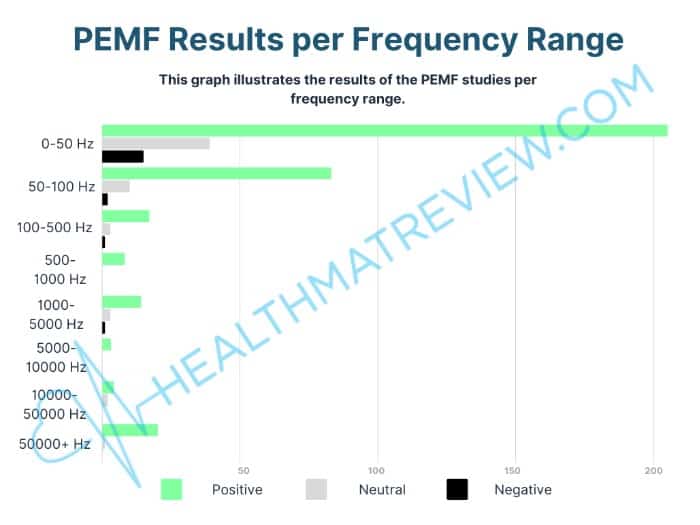

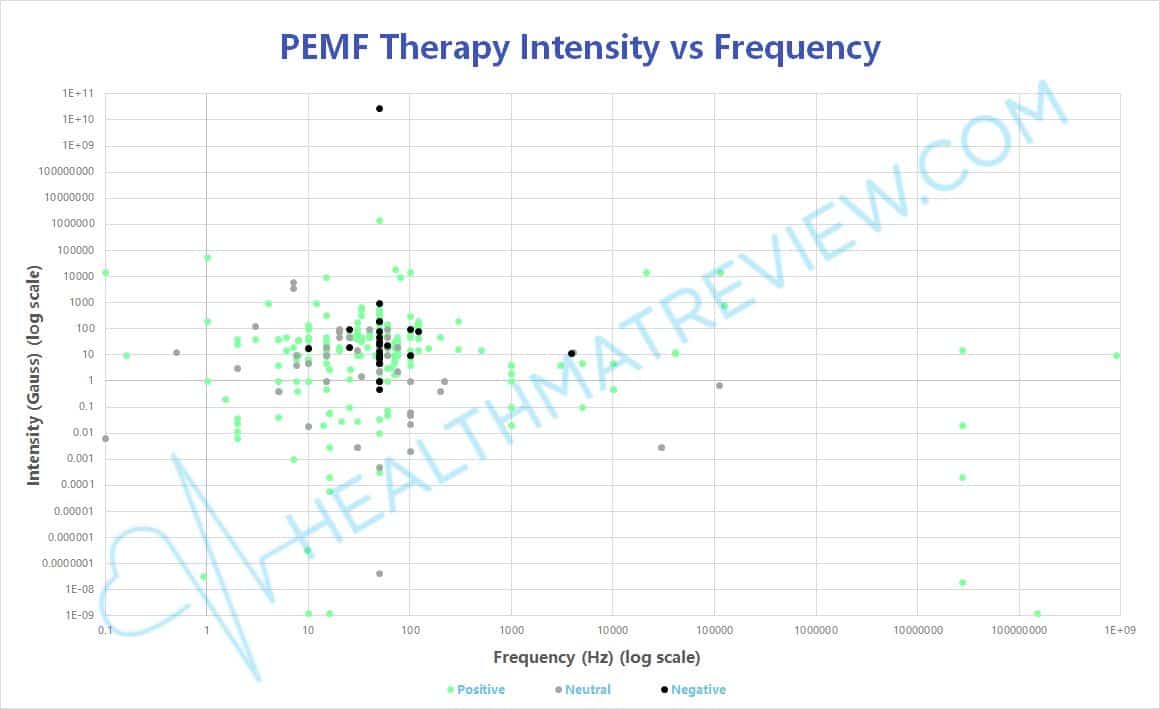

What these bar charts and the frequency/intensity setting charts show us are positive results ALL over the map: no PEMF setting is the clear #1 winner here.
Get the full process, details, and explanation
Findings
There is no “perfect” or “most effective” PEMF signal.
Positive outcomes appear across a VAST range of frequencies, intensities, and waveforms.
Certain ranges tend to have a heavier weighting of positive outcomes, such as low frequency/intensity bands.
Why it matters?
We learn almost every form of PEMF, regardless of waveform, frequency, or intensity has shown to some extent positive results in studies
This means that every PEMF mat should be beneficial in some way, and there probably isn’t “one” most effective PEMF mat or device
It means if you want the most out of PEMF, get a mat that offers the most PEMF: most frequencies, intensities, and waveforms
Get the full process, details, and explanation
Analysis Methods
Macro-Method
Find as many PEMF studies on Pubmed as possible which include PEMF setting info (frequency, intensity, waveform; we found 335)
Record the findings of the studies and their settings
Chart the PEMF settings of the studies along with the study outcomes to see where positive outcomes are found


Micro-Method
Focused on only the most relevant PEMF research studies (we found 56 in this older analysis we did)
Applied the same process as with the macro-method to find out what PEMF settings were finding positive results
Get the full process, details, and explanation
Proofs
Chart Results
The charts we made from the database showing how many positive results were within certain frequency/intensity range bands and then frequency & intensity PEMF settings which found positive results.
See the larger versions of the charts in the actual analyses below, along with full explanations like for example what the heck “log scale” means!




What these bar charts and the frequency/intensity setting charts show us are positive results ALL over the map: no PEMF setting is the clear #1 winner here.
Get the full process, details, and explanation
Full Analysis: Macro (n=335) and Micro (n=56)
Full Process, Details, Explanation
First, years ago we completed the micro analysis, of very relevant PEMF studies, a fascinating process and resulting chart (browse all those studies in table format in the analysis).
Eventually this inspired a wider macro analysis of as many PEMF studies as we could find that included PEMF setting info and (unsurprisingly?) we found the same conclusions.
Table of Contents
Macro Analysis of the 335 Study Database
In this analysis we’re going to skip the brand claims—and look only at the data.
We went looking for a pattern and found only a pattern of no pattern: many PEMF setups help, but no single setting appeared to win.
Earlier on, a few years ago I wrote a page specifically on the topic of what was the most effective PEMF therapy – you’ll now find it on the Micro Study tab above – and it is still relevant today.
In that micro study, I took into consideration 56 of the most relevant PEMF research studies I could find, and set about to see what they showed was the most effective PEMF signal, or PEMF settings.
The main takeaway from the investigation was that,
Almost every form of PEMF therapy, regardless of waveform, frequency and intensity was effective.
Meaning that,
There is no one best PEMF signal configuration.
Now having our much larger PEMF study database, we made the same investigation, and the results, perhaps unsurprisingly, remained the same.
PEMF Intensity & Frequency Settings – The Charts
First let’s look at a chart which shows all of the available frequency/intensity PEMF settings across the whole database, and to put this all onto one chart including the extreme outliers a log scale chart type was required.
A log scale chart is needed when there is a huge range of difference between the lowest and highest numbers, which was the case here for intensity and frequency (for example 0.1 Gauss to 1000 Gauss intensity, or 1 Hz to 1000 Hz frequency).
Each dot’s location shows the intensity setting along the vertical axis, and the frequency setting along the horizontal axis with green, grey and black dots representing a positive, neutral or negative result respectively.
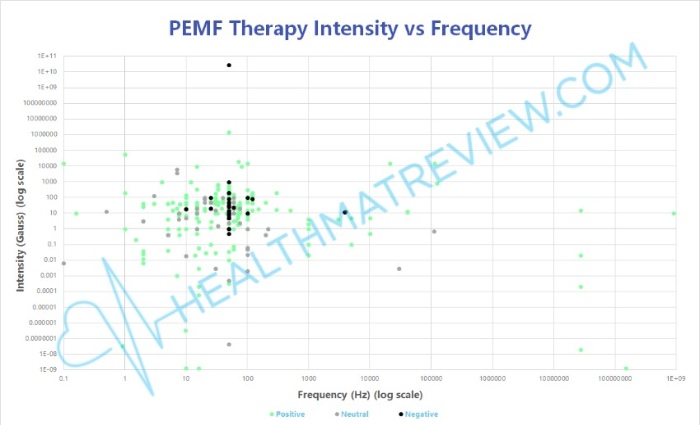
Logarithmic scale means that the graph you see above isn’t linear, each line is 10 times greater than the line next to it as you move from left to right and from bottom to top. If you’re curious Wikipedia has a good explanation of log scale.
Don’t worry if log scale doesn’t quite make sense right now, you can see all the takeaways there are to find still by simply by looking at the chart.
The takeaways from this chart remain the same as with the non-logarithmic charts that we’ll look at next, except for perhaps illustrating an even greater extreme in differences between positive result studies: where just 2 lines of difference on the chart means a frequency or intensity difference of 100 times.
There are no real patterns to be found except for the artificial ones created by studies centering their research around just one particular frequency or intensity and otherwise the distribution of results only appears as random.
Coming back to the question of what is really the most effective PEMF therapy – the logarithmic chart above shows us that:
- The studies are finding positive results in a vastly wide range of frequencies and intensities
- There is no one most effective PEMF therapy signal configuration
So the takeaway when it comes to PEMF therapy settings is really just that:
- Unless you already know the PEMF settings that will be best for you, then pick a PEMF mat that provides you the widest range of PEMF setting options for you to try for yourself
Next lets look at the charts of positive and negative result studies but this time with the extreme outlier settings removed so that we can view the results on just a regular chart, allowing us to read the Gauss and Hertz values directly.
On the following chart, we show the positive result studies indicated again by green dots, and located via their intensity level along the left hand axis, and their frequency level along the bottom axis.
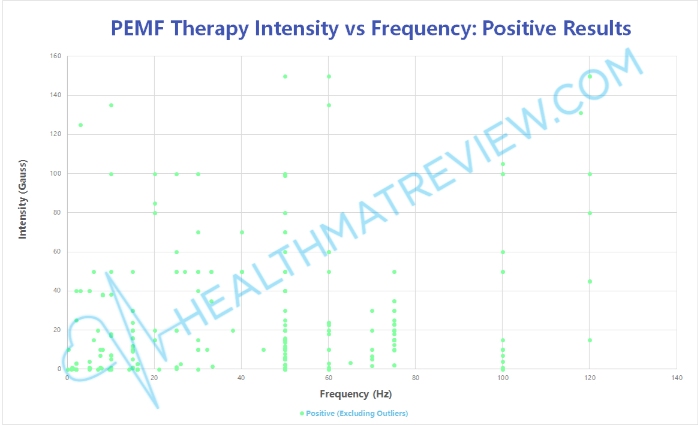
What we are seeing here are the PEMF intensity and frequency settings used in studies which provided positive results, all laid out next to each other in a graphical fashion.
Is there any pattern that we can see?
You’ll probably notice what appears like a line of dots around particular frequencies vertically or particular intensities horizontally.
This pattern however, is not only because there were many positive results coincidentally right at those numbers, but also because some studies evaluated more than one PEMF configuration but centered them around one frequency or intensity setting, resulting in the lines like we see on the chart.
The only other pattern we can see is a seemingly random distribution of where the research is finding positive results from PEMF.
Now considering the following chart, which indicates negative result studies with black dots, also located by their intensity on the vertical axis and frequency on the horizontal axis, are there any patterns to see?
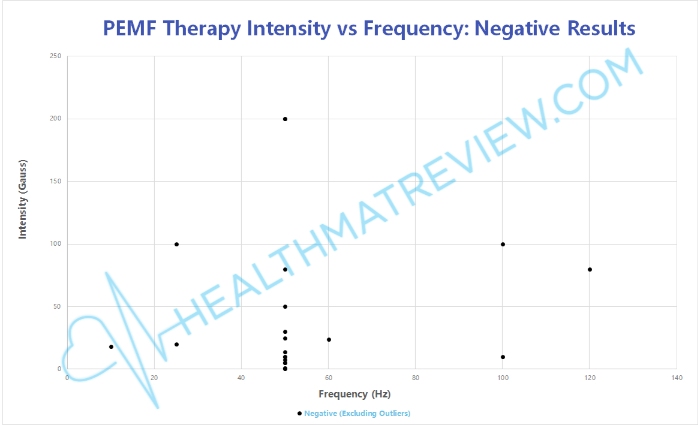
We only notice the two same things as on the positive results chart, there are some line type patterns for the same reason as with the positive result studies, but otherwise a seemingly random distribution of intensity and frequency configurations.
This leads us again toward our earlier main takeaway from the investigation of the 56 PEMF studies I made years ago,
There is no one most effective PEMF signal configuration.
Or maybe in this case we could say that there is no least effective PEMF signal configuration either.
PEMF Waveforms Bar Chart
Let’s look at what waveforms were used in the PEMF database.
The following chart shows the number of studies which used any of the particular waveforms listed along the bottom axis (this is when they reported what waveform was tested).
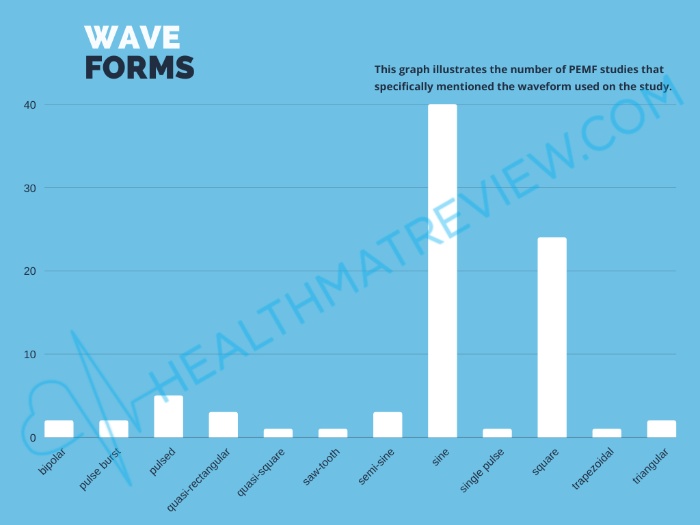
We can see that of the studies that listed their waveform type, by far the most studied waveforms in the database are the sine wave and the square wave.
Typically when a study didn’t list a waveform we may default to consider it as a sine wave as that is the typical electrical waveform – even coming out of the wall outlet power is in a sine wave.
The takeaway we can make here, is that in a database of PEMF studies showing positive results in over 80% of the studies:
- The majority of the positive result studies by far will have been performed using a sine or a square wave
Thus far we’ve only seen one PEMF mat offer both of these waveforms which is the Healthy Wave Multi-wave mat.
Intensity & Frequency Ranges – Results per Range Charts
The next two figures summarize outcomes from our dataset of PEMF studies by frequency band and by magnetic-field intensity (Gauss).
Each bar shows how many studies reported positive, neutral, or negative results within that particular range band.
You’ll see more activity (and more positives) in lower-frequency and low/moderate-intensity ranges, but positives, neutrals, and negatives appear across multiple range bands.
This mainly reflects what ranges research has been primarily focused on, but also shows a heavy distribution of positive results in the lower frequency and low to low/moderate intensity ranges.

Frequency is denoted in Hz, or Hertz, 1 Hz meaning once per second, 2 Hz being twice per second, and so on. Frequency range bands indicated along the left hand side, and number of studies noted along the bottom.
Looking first at the results per frequency range band above:
What this shows: The chart summarizes reported study outcomes (positive, neutral, negative) by PEMF frequency range across the dataset. It’s a count of results falling within each range.
Pattern in the data: Most study activity—and most positive outcomes by far (over 200)—appears in the 0–50 Hz band, with a smaller but visible cluster at 50–100 Hz. Higher-frequency ranges are represented by far fewer studies, though positives still occur.
Variability remains: Neutral and negative results appear across several bands, indicating that not every protocol within a given frequency range produces benefits.
It really only shows us what we had already suspected from our prior charts, that effective PEMF therapy is found all over the map.
One takeaway it adds however is knowing that, at least when it comes to the actual PEMF research available today:
- The majority of positive results with PEMF therapy have been found to occur at frequencies of 50 Hz or lower
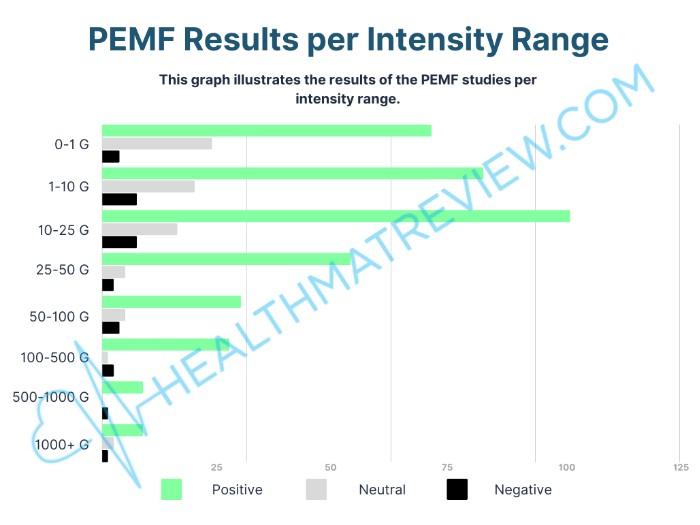
Magnetic Field Intensity is denoted in Gauss with intensity range bands indicated along the left hand side.
Next, and finally, looking at the results per intensity range band above:
What it shows: This chart groups study outcomes by magnetic field intensity (Gauss). It’s a count of studies and their results falling into each intensity range band.
Where positives cluster: Most positive outcomes in this dataset appear in the lower to moderate intensity bands of 0-1 G, 1-10 G, and 10–25 G. Very high (>100 G) ranges are less represented and show fewer positives—likely reflecting fewer studies run there.
Important to understand: not each band is the same, the 10-25 G band may show the most positive results, but it’s also a band of 15 G, compared to the 0-1 G and 1-10 G bands which combined together are only a range band of 10 G but together also represent nearly double the positive results as in the 10-25 G range band. I broke the bands out in this way because I thought it important to give representation to the lowest, and narrowest Gauss intensity band of just 0-1 G when it showed such a heavy weighting of positive results in such a narrow band.
Variability remains: Neutral and negative outcomes appear across several bands, indicating that intensity alone doesn’t guarantee results within any given range.
Once again this only reinforces our previous conclusions that there isn’t a most effective PEMF setting when it comes to intensity, however it does provide one interesting takeaway:
- The very low intensity range of 0 to 1 Gauss, the narrowest range band by far of only 1 Gauss versus the next smallest band of 10 Gauss, showed a disproportionate amount of positive result studies for the size of its’ range band
Macro Conclusions
Positive PEMF settings were found across a range of very low to very high both frequency and intensity settings however there was a definitive weighting of positive result studies in the low frequency range (<50 Hz) and lower intensity ranges (<25 G).
This may simply be indicative of more PEMF research being performed at these lower frequency and lower intensity range bands rather than outperformance of PEMF settings in these ranges, however a couple things are certain:
- There is more PEMF research supporting positive results using low frequency and low intensity (even in the very low range 0-1 G)
- There is more PEMF research supporting positive results using either a sine waveform or a square waveform more than any other PEMF waveform

Nothing revolutionary here but it’s a great place to start in our understanding of PEMF therapy in general and important basics of knowledge to have when shopping for a PEMF mat.
If you want to browse through the studies included in this macro analysis I built a searchable PEMF studies database you can use at your leisure.
Don’t forget to check out our original Micro Analysis if you haven’t already, or see how this analysis and the studies have helped us answer other questions on our PEMF therapy page.
Table of Contents
The Micro Analysis of 56 Very Relevant PEMF Studies
Welcome to the original PEMF research study analysis we performed years ago.
I’ve left most of this analysis write up un-edited since the original and it remains relevant today even mirroring the results from the more recent macro-analysis.
One section of this micro analysis you might find particularly interesting is the table of research studies I compiled for it which you can browse through page by page looking at study title, frequency and intensity.
Lets get into it.
Original Micro Analysis Article
There is one place where you can find some unbiased information on PEMF, and this is on the PubMed website.
We reviewed & summarized the findings of the most relevant 56 PEMF research articles from the PubMed website to find out what really is the effective PEMF Therapy.
What is the Most Effective PEMF?
Pulsed Electro-magnetic field therapy is a relatively new area of therapeutic practice, and its potential for great benefits has already been seen.
In this new arena of PEMF therapy there are a number of companies and brands which each have come up with their own specialized PEMF version for example the Bemer mat, among others.
These companies and brands have done excellent work in promoting the potential of PEMF therapy and specifically their exclusive brand of PEMF therapy & waveform.
Common PEMF Marketing Message Themes:
- PEMF therapy can really work, as the studies have shown
- Their brand of PEMF therapy is “the most effective”
This raises the question, What really is the most effective PEMF therapy?
To find out, we went and reviewed 56 of the most pertinent PEMF research articles which are publically available on the PubMed website.The results were promising and may be a surprise to you.
The Results:
Of the 56 studies reviewed,
50 indicated positive results
- 2 indicated positive/neutral results
- 2 indicated positive/further research required results
- Just 2 indicated only neutral results
What these studies showed us is that PEMF therapy can work.

Furthermore the review of these studies gave us some insight into what really is the most effective PEMF waveform, intensity & frequency.
We put the results in a table, and in a chart, for better visualization of the findings, read on below to find out more.
What does PubMed research say about:
What is the Most Effective PEMF Waveform?
There is no most effective PEMF waveform
Why do we say the research doesn’t show a single most effective waveform?
Most PEMF brands and companies base their claims of product effectivity upon their exclusive PEMF waveform.
What did the PubMed studies reviewed show us regarding the waveforms used?
What waveforms did the PubMed studies use?
49 of the studies reviewed did not indicate what waveform was used in the study.
Of these 49 studies which did not indicate the PEMF waveform used,
- 46 indicated positive result studies
- 3 indicated the following respectively: Neutral result, Positive/Neutral result, Positive/Further Research required result
What does it mean if a study does not indicate what waveform was used?
There are 2 things to understand about PEMF waveform.
Number 1:
The waveform is dependent on the frequency
- The higher the frequency, the shorter the waveform
- The lower the frequency, the longer the waveform
- One full wave “form” is the distance it takes to go from 0, up to the top, back through 0, to the bottom, and back up to 0 again
- See the image here for a visual representation of this

Number 2:
A standard “non-special” waveform is the “Sinusoidal” or “Sine” waveform.
- The reason a sinusoidal waveform is the standard, is because this is the waveform of the electricity that you get at your plug on the wall
- The sinusoidal waveform is the same as the red and blue waveforms shown in the image above or the red wave in the image to the right, a symmetrical wave
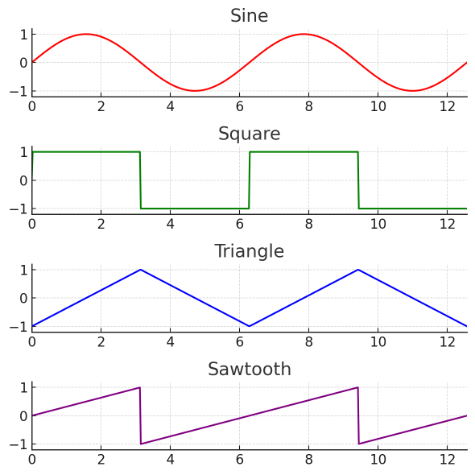
If a PEMF study does not indicate what waveform was used, this is likely because they have not created their own special waveform like some companies and brands have done and now market with their product.
If the PEMF study in question has not created their own special waveform, this means that they are using the standard sinusoidal waveform.
This is because this is the waveform we receive at the plug in the wall from the electricity grid.
What does this tell us about what is the most effective PEMF waveform?
With 46 PEMF studies with positive results not indicating any special waveform,
this indicates that the effectivity of PEMF therapy is not dependent on any one special waveform.
What does PubMed research say about:
What is the Most Effective PEMF Frequency & Intensity?
There is no most effective PEMF intensity & frequency.
So why do we say that the research shows that there is no most effective intensity & frequency?
Most current PEMF companies and brands use either just 1 intensity & frequency, or they offer multiple settings of intensity & frequency.
What did the PubMed studies reviewed show us regarding the intensity and frequencies used?
What intensities & frequencies did the PubMed studies use?
33 of the studies reviewed used entirely different intensities & frequencies.
- 30 of the entirely different intensities & frequencies indicated positive results
- 3 of the entirely different intensities & frequencies indicated positive/further research required, positive/neutral, and neutral results respectively
What does this tell us about what is the most effective PEMF frequency & intensity?
The glaring fact we can observe from these studies is that there is no one true most effective frequency or intensity.
We can see this from 30 different combinations of intensity & frequency all demonstrating positive results.
What we should bear in mind in the review of these studies is that each study was evaluating the effects of PEMF intensity & frequency on a different ailment or cell culture.
What was apparent?
What was apparent is that certain combinations of intensity & frequency were better suited for certain ailments than others.
With this being said, there was not yet nearly enough ailment specific research to draw any conclusions as to what is the best frequency and/or intensity for any particular ailment.
What did the studies evaluate?
Many of the studies evaluated intensities & frequencies far beyond those in the therapeutic range, that means that many of the studies used VERY high intensities and frequencies which should ONLY be used in a clinical setting.
Some of these clinical, very high intensity & frequency level studies were performed only on animals or cell cultures, not on humans for the likely reason that it is not known whether they are safe.
Many of the other studies evaluated & utilized intensities & frequencies that were in the therapeutic range, somewhere in the range of less than 10 Gauss, and less than a 1 kHz frequency, and these also yielded positive results.

In broad terms, in the lower therapeutic range positive results across a wide range of ailments were observed in PEMF studies testing a very large range of intensities & frequencies.
What did we learn about what is the SAFE level of intensity for PEMF?
While we found that the lower range of intensities and frequencies typically yielded positive results, higher intensities and frequencies weren’t as consistent.
Many PEMF brands, even well known like Dr. Pawluk and MagnaWave, have been promoting their extremely high intensity PEMF devices as the most effective devices available with no negative side effects.
These claims of completely safe ultra high intensity PEMF devices didn’t seem to line up with the results we saw from the research so we decided to dig deep into the research on high intensity PEMF.
We ended up finding out so much about this topic that we needed to write an entire page on high intensity PEMF, and the results might be altogether unsurprising to you.
What does this mean?
This indicates that PEMF effectivity is not dependent on any single special frequency or intensity
Check out the PEMF intensity, frequency chart below for a visual representation of this.
PEMF Frequency & Intensity Chart
Each green dot represents a positive result from a PubMed PEMF study.
The location of a green dot represents the PEMF frequency & intensity used in its PubMed study.
Note how far apart all the positive result studies are from one another!
A logarithmic scale is used on this chart, see below on How to Read & Understand this Chart

Where do popular PEMF mat products fall on this chart?
To help put things into context we’ve indicated the operation range of the 3 most popular PEMF mat products currently available.
Healthy Wave Mat – indicated with a PURPLE circle on the chart (note this is the original Pro mat, the updated Multi-wave & high intensity mats cover much more operational area)
Bemer Mat – indicated with an ORANGE circle on the chart (note, Bemer has 2 frequencies, here is shown the 33Hz position)
iMRS 2000 Mat – indicated with a YELLOW circle on the chart (note, iMRS 2000 has 4 frequencies, here is shown the 5.5Hz position)
How to Read & Understand this Chart
This is a logarithmic chart which means,
- Each line of the chart represents a factor of 10
This is important to keep in mind when comparing one study to the next or one product to the next.
It was necessary to use a logarithmic chart because frequencies & intensities of different studies were so far apart from one another that the graph was unreadable.
Read & Understand this Chart – Example
For example, the line next to a line is 10 times greater than the first, and the second line from the first line is 100 times greater (this is 2 factors of 10, 10 x 10 = 100, this is what “log scale” or “logarithmic scale” means, this factor of 10).
This means that if one green dot is one line away from the next, they’re using a frequency or intensity that is 10 times greater or less than the dot one line over. If one green dot is two lines away from the next, they’re using a frequency or intensity that is 100 times greater or less than the dot two lines over.
How did we compose this chart?
In our chart, we charted only the studies which included the information on both intensity & frequency, this was 44 of the 56 total studies reviewed.
What did we not chart on the graph above?
We did not chart the 2 studies which indicated only “Neutral” results.
We did not chart the 7 studies which only provided the frequency information and not intensity, (our chart shows both intensity and frequency of each study).
We could not chart the 5 studies which did not provide intensity or frequency information.

What do the vertical & horizontal positions mean?
As we have labeled on the sides of the chart:
the intensity of a study is indicated by the vertical position, and the frequency used by a study is indicated by its horizontal position.
Again keep in mind, each green dot represents just one positive study.
Why did we use a logarithmic scale?
We used a “log scale” for the horiztonal and vertical axis of the chart.
We used this “log scale” is because the values were so far apart that we needed a way to show them all on one chart, this is what the “log scale” allows us to do, to have each line represent 10 times the one next to it.
This means with 3 lines in between one green dot and another, one is 1,000 times higher intensity or frequency!
PubMed PEMF Research Table Data Review
We have compiled the PEMF studies we reviewed into the table below so that you can see the information for yourself.
The title of each study in the table links to its PubMed research article, and we indicate the study’s intensity, frequency, waveform, and what the results showed in these respective columns.
Summarizing the Data from the Studies in the Table
56 studies total reviewed.
What was included in the table?
51 studies are included in the table.
5 studies not included in the table did not indicate what intensity, frequency, or waveform was used, of these 4 indicated positive results, one indicated neutral results.
44 of the studies reviewed & included in the table indicated both what intensity was used & what frequency was used and of these,
- 38 indicated positive results
- 2 indicated positive/further research required
- 2 indicated positive/neutral results
- 2 indicated neutral results

7 of the reviewed studies included in the table did not indicate what intensity was used, but did indicate frequency, of these all 7 indicated positive results.
The table is searchable for your convenience and note there are multiple pages, use the “Next” & “Previous” buttons.
56 Study Searchable Table
What is the Most Effective PEMF Mat or Device?
Without examining the research and findings on PEMF that is currently available, there is no way to say which PEMF therapy is the most effective.
How can anyone, or any company or brand say that their technology is the best, without providing unbiased research to back it up?
The fact is, there is a lot that we do not yet know about PEMF, the research is ongoing, and there is undoubtedly going to be great developments in the future.

What do we know?
What we do know is that, based on the current reviewed research,
Almost every waveform, intensity and frequency of PEMF has shown to some extent positive results in the lab settings.
We also know that ultra high intensity PEMF may not be as safe as high intensity PEMF brands would have us believe, read more on what we found out on our page, Is High Intensity PEMF Safe?
The good news is that from what the studies show,
Every therapeutic PEMF machine, mat or device should be beneficial!
What does this mean?
This means that the “best PEMF device, machine, or mat”, is going to be the one that:
- Best suits your budget
- Best suits your desired therapies
- Best suits your considerations of warranty and guarantee
It also means that the “most effective PEMF machine, mat or device” is NOT going to be the one that:
- Someone says “has the best waveform”
- Someone says “has the best intensity”
- Or someone says “has the best frequency”
- Or has the highest price point

What should you know before you buy a PEMF Mat or Device?
We reviewed 56 of the most pertinent PEMF studies which we could find, based on their evaluation of PEMF and its effects on the most common ailments & pains.
What did we find out?
What we found is that,
Almost every form of PEMF therapy, regardless of waveform, frequency, and intensity was effective
to some degree within the parameters of the research performed.
What does this tell us?
What this demonstrated to us is that ,
There isn’t one be all end all most effective PEMF machine, device or mat out there
and that most devices and mats will be effective to some degree dependent on individual circumstance.
Consider the unknown & safety,
Many PEMF brands promote extreme levels of intensity as the most effective PEMF.
Seldom will these high intensity brands mention any possibility of negative effects due to the high intensity.
We dug deep into this topic and we recommend you have a read of our page, Is High Intensity PEMF Safe to find out more to help you make your own decisions.
What do we recommend?
We recommend therefore that before you buy any mat or device that you consider,
- Your budget
- Your warranty and guarantee concerns
- Whether you should consider combining PEMF with other therapies

Don’t forget to check out our newer more detailed Macro Analysis if you haven’t already!
Table of Contents
Macro Analysis of the 335 Study Database
In this analysis we’re going to skip the brand claims—and look only at the data.
We went looking for a pattern and found only a pattern of no pattern: many PEMF setups help, but no single setting appeared to win.
Earlier on, a few years ago I wrote a page specifically on the topic of what was the most effective PEMF therapy – you’ll now find it on the Micro Study tab above – and it is still relevant today.
In that micro study, I took into consideration 56 of the most relevant PEMF research studies I could find, and set about to see what they showed was the most effective PEMF signal, or PEMF settings.
The main takeaway from the investigation was that,
Almost every form of PEMF therapy, regardless of waveform, frequency and intensity was effective.
Meaning that,
There is no one best PEMF signal configuration.
Now having our much larger PEMF study database, we made the same investigation, and the results, perhaps unsurprisingly, remained the same.
PEMF Intensity & Frequency Settings – The Charts
First let’s look at a chart which shows all of the available frequency/intensity PEMF settings across the whole database, and to put this all onto one chart including the extreme outliers a log scale chart type was required.
A log scale chart is needed when there is a huge range of difference between the lowest and highest numbers, which was the case here for intensity and frequency (for example 0.1 Gauss to 1000 Gauss intensity, or 1 Hz to 1000 Hz frequency).
Each dot’s location shows the intensity setting along the vertical axis, and the frequency setting along the horizontal axis with green, grey and black dots representing a positive, neutral or negative result respectively.

Logarithmic scale means that the graph you see above isn’t linear, each line is 10 times greater than the line next to it as you move from left to right and from bottom to top. If you’re curious Wikipedia has a good explanation of log scale.
Don’t worry if log scale doesn’t quite make sense right now, you can see all the takeaways there are to find still by simply by looking at the chart.
The takeaways from this chart remain the same as with the non-logarithmic charts that we’ll look at next, except for perhaps illustrating an even greater extreme in differences between positive result studies: where just 2 lines of difference on the chart means a frequency or intensity difference of 100 times.
There are no real patterns to be found except for the artificial ones created by studies centering their research around just one particular frequency or intensity and otherwise the distribution of results only appears as random.
Coming back to the question of what is really the most effective PEMF therapy – the logarithmic chart above shows us that:
- The studies are finding positive results in a vastly wide range of frequencies and intensities
- There is no one most effective PEMF therapy signal configuration
So the takeaway when it comes to PEMF therapy settings is really just that:
- Unless you already know the PEMF settings that will be best for you, then pick a PEMF mat that provides you the widest range of PEMF setting options for you to try for yourself
Next lets look at the charts of positive and negative result studies but this time with the extreme outlier settings removed so that we can view the results on just a regular chart, allowing us to read the Gauss and Hertz values directly.
On the following chart, we show the positive result studies indicated again by green dots, and located via their intensity level along the left hand axis, and their frequency level along the bottom axis.

What we are seeing here are the PEMF intensity and frequency settings used in studies which provided positive results, all laid out next to each other in a graphical fashion.
Is there any pattern that we can see?
You’ll probably notice what appears like a line of dots around particular frequencies vertically or particular intensities horizontally.
This pattern however, is not only because there were many positive results coincidentally right at those numbers, but also because some studies evaluated more than one PEMF configuration but centered them around one frequency or intensity setting, resulting in the lines like we see on the chart.
The only other pattern we can see is a seemingly random distribution of where the research is finding positive results from PEMF.
Now considering the following chart, which indicates negative result studies with black dots, also located by their intensity on the vertical axis and frequency on the horizontal axis, are there any patterns to see?

We only notice the two same things as on the positive results chart, there are some line type patterns for the same reason as with the positive result studies, but otherwise a seemingly random distribution of intensity and frequency configurations.
This leads us again toward our earlier main takeaway from the investigation of the 56 PEMF studies I made years ago,
There is no one most effective PEMF signal configuration.
Or maybe in this case we could say that there is no least effective PEMF signal configuration either.
PEMF Waveforms Bar Chart
Let’s look at what waveforms were used in the PEMF database.
The following chart shows the number of studies which used any of the particular waveforms listed along the bottom axis (this is when they reported what waveform was tested).

We can see that of the studies that listed their waveform type, by far the most studied waveforms in the database are the sine wave and the square wave.
Typically when a study didn’t list a waveform we may default to consider it as a sine wave as that is the typical electrical waveform – even coming out of the wall outlet power is in a sine wave.
The takeaway we can make here, is that in a database of PEMF studies showing positive results in over 80% of the studies:
- The majority of the positive result studies by far will have been performed using a sine or a square wave
Thus far we’ve only seen one PEMF mat offer both of these waveforms which is the Healthy Wave Multi-wave mat.
Intensity & Frequency Ranges – Results per Range Charts
The next two figures summarize outcomes from our dataset of PEMF studies by frequency band and by magnetic-field intensity (Gauss).
Each bar shows how many studies reported positive, neutral, or negative results within that particular range band.
You’ll see more activity (and more positives) in lower-frequency and low/moderate-intensity ranges, but positives, neutrals, and negatives appear across multiple range bands.
This mainly reflects what ranges research has been primarily focused on, but also shows a heavy distribution of positive results in the lower frequency and low to low/moderate intensity ranges.

Frequency is denoted in Hz, or Hertz, 1 Hz meaning once per second, 2 Hz being twice per second, and so on. Frequency range bands indicated along the left hand side, and number of studies noted along the bottom.
Looking first at the results per frequency range band above:
What this shows: The chart summarizes reported study outcomes (positive, neutral, negative) by PEMF frequency range across the dataset. It’s a count of results falling within each range.
Pattern in the data: Most study activity—and most positive outcomes by far (over 200)—appears in the 0–50 Hz band, with a smaller but visible cluster at 50–100 Hz. Higher-frequency ranges are represented by far fewer studies, though positives still occur.
Variability remains: Neutral and negative results appear across several bands, indicating that not every protocol within a given frequency range produces benefits.
It really only shows us what we had already suspected from our prior charts, that effective PEMF therapy is found all over the map.
One takeaway it adds however is knowing that, at least when it comes to the actual PEMF research available today:
- The majority of positive results with PEMF therapy have been found to occur at frequencies of 50 Hz or lower

Magnetic Field Intensity is denoted in Gauss with intensity range bands indicated along the left hand side.
Next, and finally, looking at the results per intensity range band above:
What it shows: This chart groups study outcomes by magnetic field intensity (Gauss). It’s a count of studies and their results falling into each intensity range band.
Where positives cluster: Most positive outcomes in this dataset appear in the lower to moderate intensity bands of 0-1 G, 1-10 G, and 10–25 G. Very high (>100 G) ranges are less represented and show fewer positives—likely reflecting fewer studies run there.
Important to understand: not each band is the same, the 10-25 G band may show the most positive results, but it’s also a band of 15 G, compared to the 0-1 G and 1-10 G bands which combined together are only a range band of 10 G but together also represent nearly double the positive results as in the 10-25 G range band. I broke the bands out in this way because I thought it important to give representation to the lowest, and narrowest Gauss intensity band of just 0-1 G when it showed such a heavy weighting of positive results in such a narrow band.
Variability remains: Neutral and negative outcomes appear across several bands, indicating that intensity alone doesn’t guarantee results within any given range.
Once again this only reinforces our previous conclusions that there isn’t a most effective PEMF setting when it comes to intensity, however it does provide one interesting takeaway:
- The very low intensity range of 0 to 1 Gauss, the narrowest range band by far of only 1 Gauss versus the next smallest band of 10 Gauss, showed a disproportionate amount of positive result studies for the size of its’ range band
Macro Conclusions
Positive PEMF settings were found across a range of very low to very high both frequency and intensity settings however there was a definitive weighting of positive result studies in the low frequency range (<50 Hz) and lower intensity ranges (<25 G).
This may simply be indicative of more PEMF research being performed at these lower frequency and lower intensity range bands rather than outperformance of PEMF settings in these ranges, however a couple things are certain:
- There is more PEMF research supporting positive results using low frequency and low intensity (even in the very low range 0-1 G)
- There is more PEMF research supporting positive results using either a sine waveform or a square waveform more than any other PEMF waveform

Nothing revolutionary here but it’s a great place to start in our understanding of PEMF therapy in general and important basics of knowledge to have when shopping for a PEMF mat.
If you want to browse through the studies included in this macro analysis I built a searchable PEMF studies database you can use at your leisure.
Don’t forget to check out our original Micro Analysis if you haven’t already, or see how this analysis and the studies have helped us answer other questions on our PEMF therapy page.
Table of Contents
The Micro Analysis of 56 Very Relevant PEMF Studies
Welcome to the original PEMF research study analysis we performed years ago.
I’ve left most of this analysis write up un-edited since the original and it remains relevant today even mirroring the results from the more recent macro-analysis.
One section of this micro analysis you might find particularly interesting is the table of research studies I compiled for it which you can browse through page by page looking at study title, frequency and intensity.
Lets get into it.
Original Micro Analysis Article
There is one place where you can find some unbiased information on PEMF, and this is on the PubMed website.
We reviewed & summarized the findings of the most relevant 56 PEMF research articles from the PubMed website to find out what really is the effective PEMF Therapy.
What is the Most Effective PEMF?
Pulsed Electro-magnetic field therapy is a relatively new area of therapeutic practice, and its potential for great benefits has already been seen.
In this new arena of PEMF therapy there are a number of companies and brands which each have come up with their own specialized PEMF version for example the Bemer mat, among others.
These companies and brands have done excellent work in promoting the potential of PEMF therapy and specifically their exclusive brand of PEMF therapy & waveform.
Common PEMF Marketing Message Themes:
- PEMF therapy can really work, as the studies have shown
- Their brand of PEMF therapy is “the most effective”
This raises the question, What really is the most effective PEMF therapy?
To find out, we went and reviewed 56 of the most pertinent PEMF research articles which are publically available on the PubMed website.The results were promising and may be a surprise to you.
The Results:
Of the 56 studies reviewed,
50 indicated positive results
- 2 indicated positive/neutral results
- 2 indicated positive/further research required results
- Just 2 indicated only neutral results
What these studies showed us is that PEMF therapy can work.

Furthermore the review of these studies gave us some insight into what really is the most effective PEMF waveform, intensity & frequency.
We put the results in a table, and in a chart, for better visualization of the findings, read on below to find out more.
What does PubMed research say about:
What is the Most Effective PEMF Waveform?
There is no most effective PEMF waveform
Why do we say the research doesn’t show a single most effective waveform?
Most PEMF brands and companies base their claims of product effectivity upon their exclusive PEMF waveform.
What did the PubMed studies reviewed show us regarding the waveforms used?
What waveforms did the PubMed studies use?
49 of the studies reviewed did not indicate what waveform was used in the study.
Of these 49 studies which did not indicate the PEMF waveform used,
- 46 indicated positive result studies
- 3 indicated the following respectively: Neutral result, Positive/Neutral result, Positive/Further Research required result
What does it mean if a study does not indicate what waveform was used?
There are 2 things to understand about PEMF waveform.
Number 1:
The waveform is dependent on the frequency
- The higher the frequency, the shorter the waveform
- The lower the frequency, the longer the waveform
- One full wave “form” is the distance it takes to go from 0, up to the top, back through 0, to the bottom, and back up to 0 again
- See the image here for a visual representation of this

Number 2:
A standard “non-special” waveform is the “Sinusoidal” or “Sine” waveform.
- The reason a sinusoidal waveform is the standard, is because this is the waveform of the electricity that you get at your plug on the wall
- The sinusoidal waveform is the same as the red and blue waveforms shown in the image above or the red wave in the image to the right, a symmetrical wave

If a PEMF study does not indicate what waveform was used, this is likely because they have not created their own special waveform like some companies and brands have done and now market with their product.
If the PEMF study in question has not created their own special waveform, this means that they are using the standard sinusoidal waveform.
This is because this is the waveform we receive at the plug in the wall from the electricity grid.
What does this tell us about what is the most effective PEMF waveform?
With 46 PEMF studies with positive results not indicating any special waveform,
this indicates that the effectivity of PEMF therapy is not dependent on any one special waveform.
What does PubMed research say about:
What is the Most Effective PEMF Frequency & Intensity?
There is no most effective PEMF intensity & frequency.
So why do we say that the research shows that there is no most effective intensity & frequency?
Most current PEMF companies and brands use either just 1 intensity & frequency, or they offer multiple settings of intensity & frequency.
What did the PubMed studies reviewed show us regarding the intensity and frequencies used?
What intensities & frequencies did the PubMed studies use?
33 of the studies reviewed used entirely different intensities & frequencies.
- 30 of the entirely different intensities & frequencies indicated positive results
- 3 of the entirely different intensities & frequencies indicated positive/further research required, positive/neutral, and neutral results respectively
What does this tell us about what is the most effective PEMF frequency & intensity?
The glaring fact we can observe from these studies is that there is no one true most effective frequency or intensity.
We can see this from 30 different combinations of intensity & frequency all demonstrating positive results.
What we should bear in mind in the review of these studies is that each study was evaluating the effects of PEMF intensity & frequency on a different ailment or cell culture.
What was apparent?
What was apparent is that certain combinations of intensity & frequency were better suited for certain ailments than others.
With this being said, there was not yet nearly enough ailment specific research to draw any conclusions as to what is the best frequency and/or intensity for any particular ailment.
What did the studies evaluate?
Many of the studies evaluated intensities & frequencies far beyond those in the therapeutic range, that means that many of the studies used VERY high intensities and frequencies which should ONLY be used in a clinical setting.
Some of these clinical, very high intensity & frequency level studies were performed only on animals or cell cultures, not on humans for the likely reason that it is not known whether they are safe.
Many of the other studies evaluated & utilized intensities & frequencies that were in the therapeutic range, somewhere in the range of less than 10 Gauss, and less than a 1 kHz frequency, and these also yielded positive results.

In broad terms, in the lower therapeutic range positive results across a wide range of ailments were observed in PEMF studies testing a very large range of intensities & frequencies.
What did we learn about what is the SAFE level of intensity for PEMF?
While we found that the lower range of intensities and frequencies typically yielded positive results, higher intensities and frequencies weren’t as consistent.
Many PEMF brands, even well known like Dr. Pawluk and MagnaWave, have been promoting their extremely high intensity PEMF devices as the most effective devices available with no negative side effects.
These claims of completely safe ultra high intensity PEMF devices didn’t seem to line up with the results we saw from the research so we decided to dig deep into the research on high intensity PEMF.
We ended up finding out so much about this topic that we needed to write an entire page on high intensity PEMF, and the results might be altogether unsurprising to you.
What does this mean?
This indicates that PEMF effectivity is not dependent on any single special frequency or intensity
Check out the PEMF intensity, frequency chart below for a visual representation of this.
PEMF Frequency & Intensity Chart
Each green dot represents a positive result from a PubMed PEMF study.
The location of a green dot represents the PEMF frequency & intensity used in its PubMed study.
Note how far apart all the positive result studies are from one another!
A logarithmic scale is used on this chart, see below on How to Read & Understand this Chart

Where do popular PEMF mat products fall on this chart?
To help put things into context we’ve indicated the operation range of the 3 most popular PEMF mat products currently available.
Healthy Wave Mat – indicated with a PURPLE circle on the chart (note this is the original Pro mat, the updated Multi-wave & high intensity mats cover much more operational area)
Bemer Mat – indicated with an ORANGE circle on the chart (note, Bemer has 2 frequencies, here is shown the 33Hz position)
iMRS 2000 Mat – indicated with a YELLOW circle on the chart (note, iMRS 2000 has 4 frequencies, here is shown the 5.5Hz position)
How to Read & Understand this Chart
This is a logarithmic chart which means,
- Each line of the chart represents a factor of 10
This is important to keep in mind when comparing one study to the next or one product to the next.
It was necessary to use a logarithmic chart because frequencies & intensities of different studies were so far apart from one another that the graph was unreadable.
Read & Understand this Chart – Example
For example, the line next to a line is 10 times greater than the first, and the second line from the first line is 100 times greater (this is 2 factors of 10, 10 x 10 = 100, this is what “log scale” or “logarithmic scale” means, this factor of 10).
This means that if one green dot is one line away from the next, they’re using a frequency or intensity that is 10 times greater or less than the dot one line over. If one green dot is two lines away from the next, they’re using a frequency or intensity that is 100 times greater or less than the dot two lines over.
How did we compose this chart?
In our chart, we charted only the studies which included the information on both intensity & frequency, this was 44 of the 56 total studies reviewed.
What did we not chart on the graph above?
We did not chart the 2 studies which indicated only “Neutral” results.
We did not chart the 7 studies which only provided the frequency information and not intensity, (our chart shows both intensity and frequency of each study).
We could not chart the 5 studies which did not provide intensity or frequency information.

What do the vertical & horizontal positions mean?
As we have labeled on the sides of the chart:
the intensity of a study is indicated by the vertical position, and the frequency used by a study is indicated by its horizontal position.
Again keep in mind, each green dot represents just one positive study.
Why did we use a logarithmic scale?
We used a “log scale” for the horiztonal and vertical axis of the chart.
We used this “log scale” is because the values were so far apart that we needed a way to show them all on one chart, this is what the “log scale” allows us to do, to have each line represent 10 times the one next to it.
This means with 3 lines in between one green dot and another, one is 1,000 times higher intensity or frequency!
PubMed PEMF Research Table Data Review
We have compiled the PEMF studies we reviewed into the table below so that you can see the information for yourself.
The title of each study in the table links to its PubMed research article, and we indicate the study’s intensity, frequency, waveform, and what the results showed in these respective columns.
Summarizing the Data from the Studies in the Table
56 studies total reviewed.
What was included in the table?
51 studies are included in the table.
5 studies not included in the table did not indicate what intensity, frequency, or waveform was used, of these 4 indicated positive results, one indicated neutral results.
44 of the studies reviewed & included in the table indicated both what intensity was used & what frequency was used and of these,
- 38 indicated positive results
- 2 indicated positive/further research required
- 2 indicated positive/neutral results
- 2 indicated neutral results

7 of the reviewed studies included in the table did not indicate what intensity was used, but did indicate frequency, of these all 7 indicated positive results.
The table is searchable for your convenience and note there are multiple pages, use the “Next” & “Previous” buttons.
56 Study Searchable Table
What is the Most Effective PEMF Mat or Device?
Without examining the research and findings on PEMF that is currently available, there is no way to say which PEMF therapy is the most effective.
How can anyone, or any company or brand say that their technology is the best, without providing unbiased research to back it up?
The fact is, there is a lot that we do not yet know about PEMF, the research is ongoing, and there is undoubtedly going to be great developments in the future.

What do we know?
What we do know is that, based on the current reviewed research,
Almost every waveform, intensity and frequency of PEMF has shown to some extent positive results in the lab settings.
We also know that ultra high intensity PEMF may not be as safe as high intensity PEMF brands would have us believe, read more on what we found out on our page, Is High Intensity PEMF Safe?
The good news is that from what the studies show,
Every therapeutic PEMF machine, mat or device should be beneficial!
What does this mean?
This means that the “best PEMF device, machine, or mat”, is going to be the one that:
- Best suits your budget
- Best suits your desired therapies
- Best suits your considerations of warranty and guarantee
It also means that the “most effective PEMF machine, mat or device” is NOT going to be the one that:
- Someone says “has the best waveform”
- Someone says “has the best intensity”
- Or someone says “has the best frequency”
- Or has the highest price point

What should you know before you buy a PEMF Mat or Device?
We reviewed 56 of the most pertinent PEMF studies which we could find, based on their evaluation of PEMF and its effects on the most common ailments & pains.
What did we find out?
What we found is that,
Almost every form of PEMF therapy, regardless of waveform, frequency, and intensity was effective
to some degree within the parameters of the research performed.
What does this tell us?
What this demonstrated to us is that ,
There isn’t one be all end all most effective PEMF machine, device or mat out there
and that most devices and mats will be effective to some degree dependent on individual circumstance.
Consider the unknown & safety,
Many PEMF brands promote extreme levels of intensity as the most effective PEMF.
Seldom will these high intensity brands mention any possibility of negative effects due to the high intensity.
We dug deep into this topic and we recommend you have a read of our page, Is High Intensity PEMF Safe to find out more to help you make your own decisions.
What do we recommend?
We recommend therefore that before you buy any mat or device that you consider,
- Your budget
- Your warranty and guarantee concerns
- Whether you should consider combining PEMF with other therapies

Don’t forget to check out our newer more detailed Macro Analysis if you haven’t already!
If you’ve made it this far down the page, thank you for taking the time to read these whole articles.
We really appreciate it, believe it or not it took months to compile so many PubMed studies, evaluate the data and present it to you.
Frequently asked Questions
Our analysis finds effective results across a vastly wide range rather than a single ‘best’ setting. Frequencies in the low‑Hz with low/moderate field strengths often appear in positive‑outcome studies, (most heavily in 0-50 Hz and 0-25 Gauss) however optimal values depend on the indication and protocol.
Sine and square waveforms are the most commonly reported by FAR within our database. This does not mean that they are more effective than any other waveform – however we can say they are with certainty the most widely studied to date within PEMF research and show heavy weighting of positive outcomes in studies.
Not necessarily. Many positive studies use moderate or even very, very low intensities. Higher isn’t consistently better; outcomes reflect the combination of frequency, intensity, waveform, target tissue, and session dosing.
Use our charts and study table to see where a device’s frequency and field strength sit relative to evidence‑rich ranges for your goal, and review device safety and protocol guidance before use. Based upon our findings for most people look for between 1-50 Hz, 0-25 Gauss and either Sine or Square waves or both.
We searched PubMed for PEMF terms (many variations of them), then recorded the study’s “about”, “summary”, “methods” etc. and from there recorded signal parameters (frequency, intensity, waveform) and the study’s reported outcome into our own custom database. We excluded items without enough signal detail to compare.
Where needed, we normalized magnetic field units to Gauss and recorded waveform labels exactly as described by the authors, so frequency/intensity ranges can be compared across studies. When it came to labelling study topics we took studies that were extremely specific and recorded them under umbrella broader topics.
No. Positive outcomes occur across a broad range; some low-frequency/moderate-intensity regions are dense with positives, but results depend on indication and protocol design, not a single magic point. There is in plain terms however more PEMF research supporting positive results at low intensity (even 0-1 Gauss, and from 1-25 Gauss) and at lower frequencies from 0-50 Hz.




Comments are moderated. Tick “Email me when my question is replied to” to get notified.